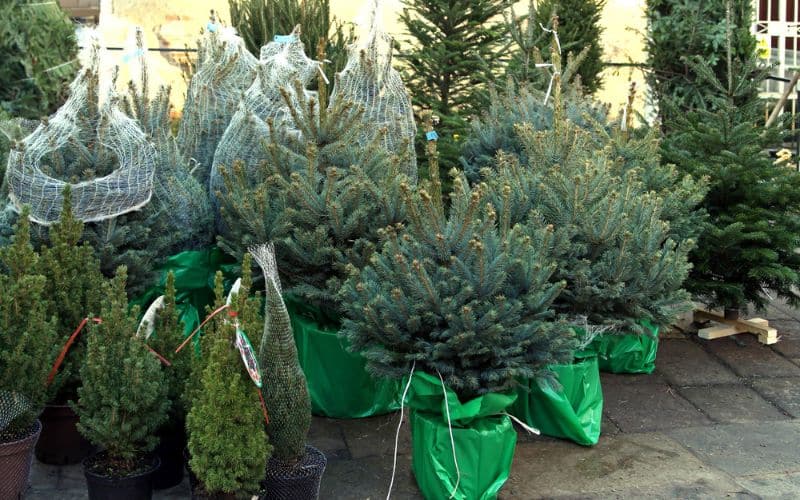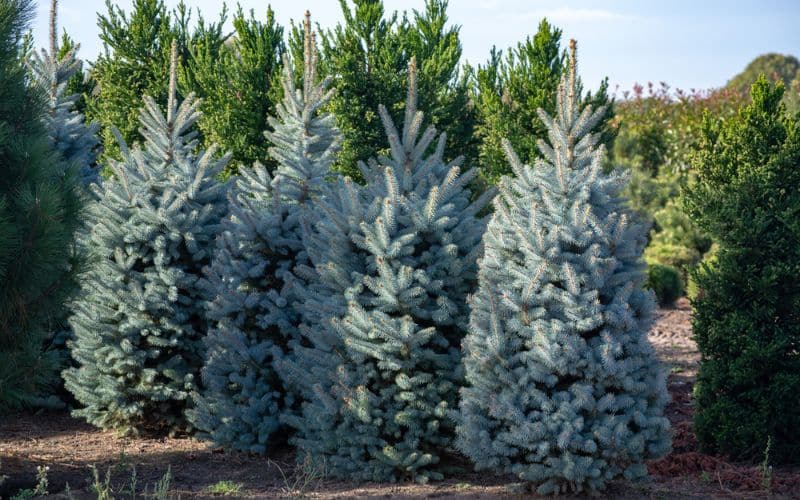
Ever considered growing your own Christmas tree and pondered over the time it takes? While some species can shoot up to towering heights within a few years, the journey from a tiny seed to a lush, five-foot Christmas tree typically spans 7 to 10 years. This article will delve into the growth timelines for various types of Christmas trees, each with its unique pace and care requirements.
You’ll discover that, beyond the festive cheer, these evergreens play a vital role in sequestering carbon emissions. Whether it’s the slow growers inching up at a foot a year or the swift developers shooting up two to four feet, growing your own Christmas tree is a commitment. Stay tuned as we guide you through planting and nurturing your yuletide centrepiece to ensure it thrives for seasons to come.
Factors Affecting the Growth of a Christmas Tree
As you delve into the intricacies of growing a Christmas tree, understanding the factors that influence its growth is crucial to achieving the majestic centerpiece of your holiday decor.
Climate
Your Christmas tree is greatly influenced by the climate it’s grown in. For instance, if you’re situated in a location with the ideal climate for the species you’ve chosen, the growth rate can be significantly improved. Providing adequate water when the soil dries, supplying essential fertilizers, and ensuring adequate sunlight exposure are all central to facilitating healthful growth. Additionally, specific species like the drought-tolerant Douglas fir can withstand slightly warmer conditions typically found in zones 4-6, showcasing their adaptability.
Species
The particular species of Christmas tree you select has a direct impact on not only how swiftly it grows but also its physical qualities and hardiness. Spruces, for example, with their sharp needles and less-than-ideal needle retention, are better suited to cooler climates. Climate zones are a reliable guide here, with Norway Spruces flourishing in zones 2-7. Conversely, pines generally exhibit faster growth and can adapt to a variety of climates, with certain varieties like the White Pine maturing within 6 years in climate zones 3-8.
Soil Quality
Finally, the quality of the soil where your Christmas tree takes root is a determining factor in its overall health and growth rate. Christmas tree species like the Virginia Pine thrive even in poor soils, speaking volumes about the plant’s adaptability. It’s worthwhile to note that trees often grow on lands unsuitable for other crops, meaning their cultivation can turn otherwise unproductive areas into lush vegetative sites. Moreover, sites like those populated with Arizona Cypress can see rapid growth in optimal soil conditions, achieving heights of 6 to 7 feet in as little as four years in zones 7-9.
When considering soil quality, remember that the practice of annual fertilization, pruning, and crop protection goes a long way in promoting a robust and vibrant tree that will stand tall for many festive seasons to come.
How Long Does It Take to Grow a Christmas Tree?
Seed to Planting
To embark on your Christmas tree-growing journey, you begin with a seed. Expect a dedicated preparation process before planting outdoors. First, mimic a cold dormancy period: wrap your seeds in a damp paper towel and refrigerate for a few weeks. This enhances germination chances. Once roots appear, it’s time to prepare for planting. Use an equal mix of peat, vermiculite, and perlite, or soil from a field or forest, in a container with drainage. Plant the seeds a third of an inch apart, and if sunlight is scarce, consider artificial light sources to nurture the seeds.
Initial Growth
After germination, the subsequent growth is slow, particularly for the first few years. Once saplings reach approximately 2-4 years old in nursery conditions, they’re transferred to outdoor farms. Here, growth is gradual, averaging one foot per year. Throughout these initial growth phases, they’re referred to as “seedlings.” The vibrant green hues and rich foliage develop with time and proper care. Your seedlings’ journey reflects patience as much as it does nurturing.
Regular Maintenance
As your trees mature, regular maintenance is crucial. Fertilization ensures the rich green color returns after the lighter hue from initial planting. You’ll also need to maintain the trees through pruning and shearing—critical to shape and density. Pruning isn’t purely aesthetic; it helps the tree grow fuller and healthier. Without this, trees may grow tall and thin, lacking the robust form desired for a traditional Christmas tree.
Harvesting Time
The journey from a seed to a tree worthy of a festive living room takes approximately 10-12 years for a 6-7ft tree. Despite slow beginnings, harvesting time is a crucial conclusion of this painstaking process. Trees often grow the fastest in the last few years pre-harvest, with some species capable of growing two to four feet within a year. When harvesting, growers select trees that have reached the desired height and shape, reflecting the results of careful cultivation and the passage of time.
Tips for Growing a Christmas Tree
Selecting the Right Species
When you’re planning to grow a Christmas tree, choosing the appropriate species is key to your success. Your local climate plays a crucial role in deciding which tree will thrive. Firs are a top pick due to their pleasant scent and needle retention, ideal for cooler climates. Species like the Fraser Fir and Balsam Fir are built for cold, whereas the Douglas Fir and Concolor Fir can tolerate slightly warmer conditions.
Consider your hardiness zone and elevation when selecting a species. The Fraser Fir excels between 3,000 to 5,000 feet with slightly acidic soil—pH 6.5 to 6.8. Always ensure the species you choose matches your climate’s characteristics for optimal growth.
Proper Planting Technique
The planting process significantly impacts the development of your Christmas tree. For seedlings, mimic the nursery conditions by planting them at the same depth they grew in before. Look for a color change on the stem as a guide. It’s essential to spread the roots evenly in the planting hole and avoid planting them too deep or shallow to prevent stress on the tree.
With container-grown trees, ensure proper stratification beforehand and plant while the tree is dormant. Your hole should be twice as wide as the root ball and filled with soil gently but firmly. Don’t forget to water immediately after planting to settle the soil around the roots.
Providing Adequate Water and Nutrients
Watering is vital, especially in the initial stages of growth. If you start with a seedling, water it weekly to maintain consistent moisture. For container trees, the top inch of soil should be dry before watering again. Additionally, weed control protects your young tree by preventing resource competition.
Monitor soil conditions and fertilize accordingly. Trees need various nutrients throughout their life cycle, but over-fertilization can be detrimental. Understand your soil’s unique needs based on pH and nutrient levels to avoid under or overfeeding your tree.
Pruning and Shaping
Pruning and shaping are not just for aesthetics; they’re also about tree health. Start shaping your tree a few years into growth, encouraging a classic Christmas tree shape—broad at the base and tapering to a point. Remove competing leaders early, and selectively thin branches to promote even growth and air circulation, reducing the risk of disease.
Regular maintenance through correct pruning and shearing ensures a robust and symmetrical Christmas tree, ideal for your holiday celebrations. Remember, too, that each species may require specific pruning techniques, so tailor your approach to your tree’s unique needs.
Common Challenges in Growing Christmas Trees
When you dedicate yourself to the rewarding process of growing a Christmas tree, it’s important to be aware of the challenges you’ll face. Maintaining the health and shape of your tree over the years requires attention to detail and perseverance.
Pest and Disease Control
Pest and disease control is crucial for the health of your Christmas tree. Common pests include aphids, spider mites, and the balsam woolly adelgid, which can cause significant damage if left unchecked. Fungal diseases like root rot and needle cast can also jeopardise your tree’s vitality. Regular monitoring is essential; inspect your tree often for signs of infestation or disease. Early detection often means simpler, more effective treatment. Use organic pesticides as necessary, as they’re usually less harmful to the environment. In severe cases, contact an ISA-certified arborist to professionally assess and manage the situation.
Weed Control
Weed control is another pivotal aspect of Christmas tree cultivation. Weeds compete with your tree for water and nutrients, potentially stunting its growth. Mulching is a highly recommended practice as it suppresses weed growth while also retaining soil moisture. If you opt for a weed-killing solution, you have a choice between organic weed killers or chemical pesticides. Organic options are preferable, as they are less likely to cause harm to surrounding flora and fauna. Remember, mowing and careful weedeating around the tree are necessary to prevent weeds from taking over without damaging the tree’s roots.
Environmental Factors
Lastly, environmental factors significantly influence your Christmas tree’s development. These factors include the amount of sunlight, precipitation, and the local climate specific to your region. Nordmann firs, for instance, grow more slowly in areas like Scotland due to reduced sunlight but often result in a fuller tree. Be mindful of drought conditions and water your tree accordingly during dry spells, especially after the first year when it’s less established. Sudden changes in temperature or extreme weather events can also be detrimental. Therefore, selecting a tree species suited to your local climate and being prepared to intervene with measures like protective netting or additional watering can aid in overcoming these natural challenges.
Arming yourself with knowledge on these common challenges will enhance your ability to grow a healthy, robust Christmas tree. Regular care and vigilance will ensure that your tree thrives, bringing joy and festivity for years to come.
Conclusion
Growing your own Christmas tree is a rewarding endeavour that requires patience and dedication. Armed with the right knowledge on species selection, planting, and maintenance, you’re well on your way to nurturing a tree that’ll be the centrepiece of your festive celebrations for years to come. Remember, regular care and vigilance are key to overcoming the challenges that might arise. So stay committed to the process and before you know it, you’ll have a lush, beautiful Christmas tree that’s a true testament to your gardening prowess.
Colin Macmillan is a seasoned entrepreneur and the CEO of Riverwood Landscape, a leading landscaping company based in Canada. He has been at the helm of the company since leaving high school, demonstrating his strong leadership skills and business acumen.
Colin’s expertise lies in various aspects of landscaping, including lawn care, interlocking, sod installation, and commercial maintenance. His hands-on approach and dedication to the craft have been instrumental in building Riverwood Landscape into a reputable brand.
One of his most notable achievements is the creation of a successful landscape franchise that services multiple locations. This accomplishment underscores his strategic thinking and ability to scale operations effectively.
Colin has also had the privilege of working with Guelph Hospital for landscaping and maintenance, a testament to the trust and reliability that his company has earned over the years.
His professional mission is to offer the best services and experiences for customers, a goal that he tirelessly pursues. Colin’s commitment to excellence and customer satisfaction continues to drive the growth and success of Riverwood Landscape.










